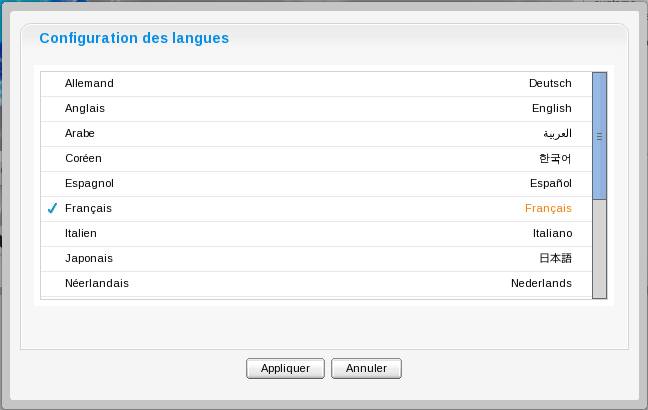NavigationPortlet_de.properties NavigationPortlet_en.properties NavigationPortlet_es.properties NavigationPortlet_fr.properties NavigationPortlet_nl.properties NavigationPortlet_ru.properties NavigationPortlet_uk.properties NavigationPortlet_ar.xml
GateIn Portal 3.8 is fully configurable for internationalization; however, users should have a general knowledge of Internationalization in Java products before attempting these configurations.
Sun Java hosts a comprehensive guide to internationalize Java products at http://java.sun.com/docs/books/tutorial/i18n/TOC.html.
All GateIn Portal 3.8 applications contain property files for various languages. They are packaged with the portlets applications in a WEB-INF/classes/locale/ directory.
These files are located in the classes folder of the WEB-INF directory to be loaded by the class loader.
All resource files are in a subfolder named locale.
For example, the translations for the NavigationPortlet are located in web.war/WEB-INF/classes/locale/portlet/portal.
Those files contain typical key=value Java EE properties. For example, the French one:
javax.portlet.title=Portlet Navigation
There are also properties files in the portal itself. They form the portal resource bundle.
From a portlet, you can then access translations from the portlet itself or shared at the portal level, both are aggregated when you need them.
It is also possible to use a proprietary XML format to define translations. This is a more convenient way for languages, such as Japanese, Arabic or Russian. Property files have to be ISO 8859-1 encoded with Unicode escape sequences, while the XML file can define its encoding. As a result, it is easier for you to read or edit a translation in XML instead of handling the Unicode escape sequences in property files.
For more information, refer to XML Resources Bundles.
Locales configuration
Various languages are available in the portal package. The configuration below will define which languages shown in the "Change Language" section and made available to users.
The portal.war:/WEB-INF/conf/common/common-configuration.xml file of your installation contains the following section:
<component>
<key>org.exoplatform.services.resources.LocaleConfigService</key>
<type>org.exoplatform.services.resources.impl.LocaleConfigServiceImpl</type>
<init-params>
<value-param>
<name>locale.config.file</name>
<value>war:/conf/common/locales-config.xml</value>
</value-param>
</init-params>
</component>
This configuration points to the locale configuration file (portal.war:/WEB-INF/conf/common/locales-config.xml) which contains the following code:
<?xml version="1.0" encoding="UTF-8"?>
<locales-config>
<locale-config>
<locale>en</locale>
<output-encoding>UTF-8</output-encoding>
<input-encoding>UTF-8</input-encoding>
<description>Default configuration for english locale</description>
</locale-config>
<locale-config>
<locale>fr</locale>
<output-encoding>UTF-8</output-encoding>
<input-encoding>UTF-8</input-encoding>
<description>Default configuration for the french locale</description>
</locale-config>
<locale-config>
<locale>ar</locale>
<output-encoding>UTF-8</output-encoding>
<input-encoding>UTF-8</input-encoding>
<description>Default configuration for the arabic locale</description>
<orientation>rt</orientation>
</locale-config>
</locales-config>
locale: This has to be defined, such as http://ftp.ics.uci.edu-pub-ietf-http-related-iso639.txt. In this example, "ar" is Arabic.
output-encoding: This deals with the character encoding. It is recommended that UTF-8 be used.
input-encoding: In the Java implementation, the encoding parameters will be used for the request response stream. The input-encoding parameter will be used for requesting setCharacterEncoding(..).
description: Brief description of the language.
orientation: The default orientation of text and images is Left-To-Right. GateIn Portal 3.8 supports Right-To-Left orientation. Modifying the text orientation is explained in RTL (Right To Left) Framework.
ResourceBundleService
The resource bundle service is configured in portal.war:/WEB-INF/conf/common/common-configuration.xml.
<component>
<key>org.exoplatform.services.resources.ResourceBundleService</key>
<type>org.exoplatform.services.resources.impl.SimpleResourceBundleService</type>
<init-params>
<values-param>
<name>classpath.resources</name>
<description>The resources that start with the following package name should be load from file system</description>
<value>locale.portlet</value>
</values-param>
<values-param>
<name>init.resources</name>
<description>Initiate the following resources during the first launch</description>
<value>locale.portal.expression</value>
<value>locale.portal.services</value>
<value>locale.portal.webui</value>
<value>locale.portal.custom</value>
<value>locale.navigation.portal.classic</value>
<value>locale.navigation.group.platform.administrators</value>
<value>locale.navigation.group.platform.users</value>
<value>locale.navigation.group.platform.guests</value>
<value>locale.navigation.group.organization.management.executive-board</value>
</values-param>
<values-param>
<name>portal.resource.names</name>
<description>The properties files of the portal , those file will be merged
into one ResoruceBundle properties </description>
<value>locale.portal.expression</value>
<value>locale.portal.services</value>
<value>locale.portal.webui</value>
<value>locale.portal.custom</value>
</values-param>
</init-params>
</component>
classpath.resources: This is discussed in the later section.
init.resources: Initiate resources related to portal, group, user resource bundles.
portal.resource.names: Define all resources that belong to the Portal Resource Bundle.
These resources are merged into a single resource bundle which is accessible from anywhere in GateIn Portal 3.8. All these keys are located in the same bundle, which is separated from the navigation resource bundles.
Portlets
Portlets are independent applications and deliver their own resource files.
All shipped portlet resources are located in the locale/portlet subfolder. The ResourceBundleService parameter called classpath.resources defines this subfolder.
Add a Spanish translation to the GadgetPortlet
-
Create the GadgetPortlet_es.properties file in WEB-INF/classes/locale/portlet/gadget/GadgetPortlet.
-
Add Spanish as a supported-locale to portlet.xml ('es' is the 2 letters code for Spanish). The resource-bundle is already declared and is the same for all languages:
<supported-locale>en</supported-locale> <supported-locale>es</supported-locale> <resource-bundle>locale.portlet.gadget.GadgetPortlet</resource-bundle>
See the portlet specification for more details about the portlet internationalization.
Standard portlet resource keys
The portlet specifications define three standard keys: Title, Short Title and Keywords. Keywords are formatted as a comma-separated list of tags.
javax.portlet.title=Breadcrumbs Portlet javax.portlet.short-title=Breadcrumbs javax.portlet.keywords=Breadcrumbs, Breadcrumb
Debugging resource bundle usage
When translating an application, it can sometimes be importamt to find out which key underlies some given given label in the user interface. GateIn Portal offers Magic locale to handle such situations.
With Magic locale the portal visitor sees the keys themselves in the graphical user interface. For example, the translated value of the "organization.title" key is "organization.title" itself.
To be able to select Magic locale from the list of available locales, you need to start the portal in development mode. This can be done through setting the java system property exo.product.developing to true. For example, the property can be passed as a JVM parameter on portal start up:
$JBOSS_HOME/bin/standalone.sh -Dexo.product.developing=true
Translate the language selection form

When choosing a language as on the screenshot above, the user is presented with a list of languages on the left side in the current chosen language and on the right side, the same language translated into its own language. Those texts are obtained from the JDK API java.util.Locale.getDisplayedLanguage() and java.util.Locale.getDisplayedCountry() (if needed) and all languages may not be translated and can also depend on the JVM currently used. It is still possible to override those values by editing the locale.portal.webui resource bundle, to do so edit the gatein.ear/portal.war/WEB-INF/classes/locale/portal/webui_xx_yy.properties file where xx_yy represents the country code of the language in which you want to translate a particular language. In that file, add or modify a key such as Locale.xx_yy with the value being the translated string.
First, edit gatein.ear/portal.war/WEB-INF/classes/locale/portal/webui_fr.properties where ne is the country code for French, and add the following key into it:
Locale.zh_TW=Chinois traditionnel
After a restart, the language will be updated in the user interface when a user is trying to change the current language.